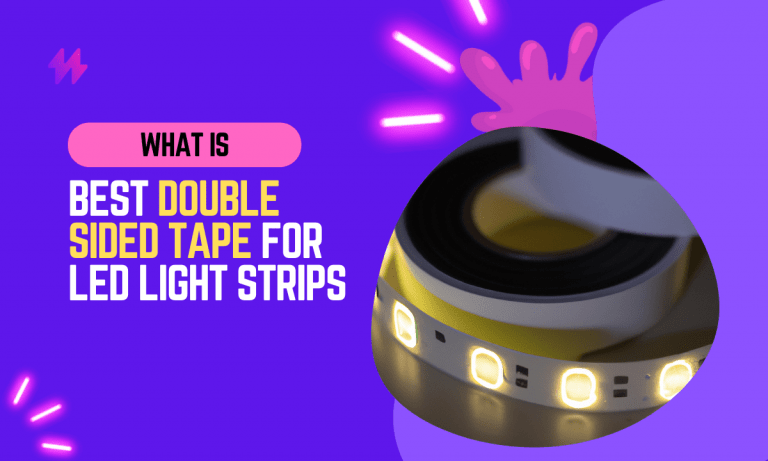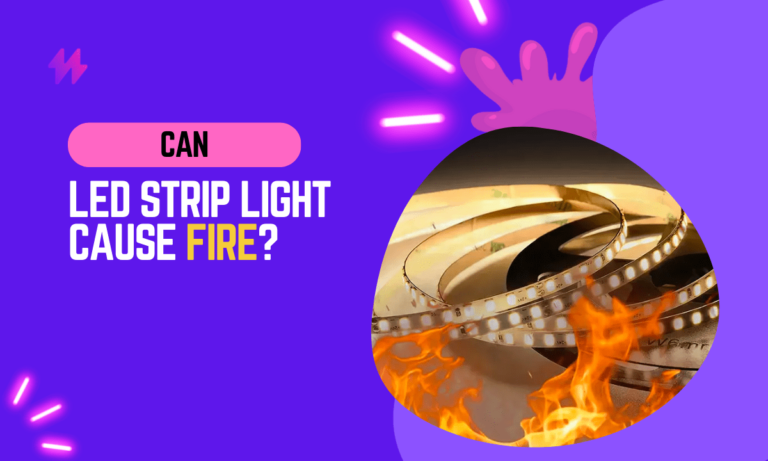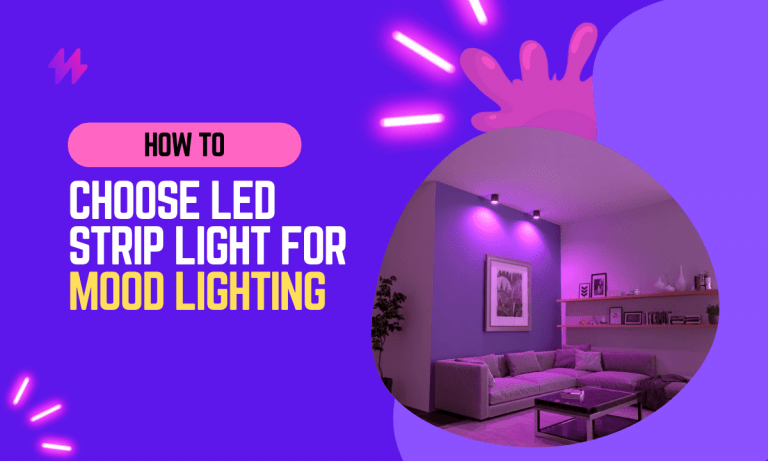Do LED Strip Lights Need a Heat Sink?
LED strip lights are a popular choice for lighting up homes, businesses, and other spaces. They’re energy-efficient, long-lasting, and come in a variety of colors and styles. But one question that often comes up is whether or not LED strip lights need a heat sink.
In this article, I’ll discuss the purpose of heat sinks, how they work, and whether or not LED strip lights need them. I’ll also share my own experience as a LED light technician with over 10 years of experience.
Incorporating LED strip lights into your space can enhance both aesthetics and functionality. It’s essential to understand that while heat sinks are an important part of LED lighting, our LED light strips do not require heat sinks due to their efficient thermal management design.
Understanding Heat Sinks: Why Do LED Strip Lights Need Them?
A heat sink is a device that is used to dissipate heat. It does this by transferring heat from a hotter object to a cooler object. Heat sinks are typically made of metal, and they have a large surface area that allows for efficient heat transfer.
Heat sinks play a crucial role in managing the temperatures generated by high-power LEDs, ensuring that the thermal conductivity is optimal for the efficient operation of LED systems. In applications like grow lights and reef tank lights, good heat sinking is essential to meet the heat dissipation requirements and maintain the performance of the light fixture.
Understanding How Heat Sinks Work for LED Strip Lights
When heat is applied to a heat sink, the metal atoms in the heat sink begin to vibrate. This vibration causes the electrons in the metal to move more quickly, which creates heat. The heat is then transferred to the cooler air around the heat sink, where it is dissipated.
The effective use of a heat spreader can significantly improve the thermal transfer of LED lighting products, allowing for optimal performance of light sources in various applications. By ensuring that internal heat is efficiently dissipated, makers of LED cooling systems can maintain lower LED junction temperatures, enhancing the overall lifespan and performance of strip lights.
Do LED Strip Lights Require a Heat Sink? Understanding Importance and Selection
LED strip lights do not generate as much heat as other types of lighting, such as incandescent bulbs or halogen bulbs. This is because LEDs are much more efficient at converting electrical energy into light energy. However, even though LED strip lights do not generate as much heat as other types of lighting, they can still benefit from the use of a heat sink.
In my experience as a LED light technician, I have found that LED strip lights that are installed in enclosed spaces or that are exposed to high levels of heat benefit the most from the use of a heat sink. This is because the enclosed space or the high levels of heat can cause the LED strip lights to overheat, which can shorten their lifespan and reduce their brightness.
If you are considering installing LED strip lights in an enclosed space or in an area that is exposed to high levels of heat, I recommend using a heat sink to protect your investment.
In the next section of this article, I will discuss the different types of heat sinks that are available for LED strip lights. I will also provide some tips on how to choose the right heat sink for your application.
In certain circumstances, the addition of a heat sink can effectively manage unwanted heat generated by LED strip lights. As a result, makers can ensure their lighting products operate at optimal levels, improving the thermal control and increasing the radiant efficiency of specific LEDs.
Do LED Strip Lights Require a Heat Sink? Understanding Importance and Selection
LED strip lights are a popular choice for lighting accents, under-cabinet lighting, and other applications. But do LED strip lights need a heat sink?
The answer is: it depends.
In this article, we’ll discuss the factors that affect whether or not an LED strip light needs a heat sink. We’ll also provide some tips on how to choose the right heat sink for your LED strip light.
When considering LED strip lights, it’s crucial to assess the thermal needs of your specific setup. Understanding how heat needs are influenced by the environment, and the choice of fixtures can help in selecting the right lighting products to enhance your space. Additionally, makers of LED heat sink solutions can offer guidance on maintaining the proper heat sink surface for efficient thermal management.
Understanding Heat Sinks: Why Do LED Strip Lights Need Them?
A heat sink is a device that is used to dissipate heat. It does this by transferring heat from the LED strip light to a larger surface area, which allows the heat to dissipate more easily.
Heat sinks are typically made of metal, and they can have a variety of shapes and sizes. The most common type of heat sink for LED strip lights is a flat, rectangular plate.
Incorporating efficient heat sinks into your design is vital for maintaining the longevity of lighting products. Makers of LED heat sink solutions play a crucial role in developing innovations that ensure optimal performance for strip lights and help prevent overheating in environments where LED temperatures can rapidly rise.
Understanding Why LED Strip Lights Require a Heat Sink: Key Insights
LED strip lights generate heat as they operate. This is because the electrical current flowing through the LEDs creates resistance, which in turn generates heat.
If the heat from the LEDs is not dissipated properly, it can damage the LEDs and shorten their lifespan. In some cases, it can even cause the LEDs to fail completely.
Proper thermal management is essential to ensure that LED strip lights function optimally without overheating. By utilizing effective heat sink solutions, makers can significantly enhance the performance and longevity of lighting products, preventing issues related to excess heat in LED systems.
Factors Influencing the Need for a Heat Sink in LED Strip Lights
There are a few factors that affect whether or not an LED strip light needs a heat sink. These factors include:
There are a few factors that affect whether or not an LED strip light needs a heat sink. These factors include the environment in which the lights are installed, the wattage of the lights used, and the overall design of the lighting products that are being considered. The makers of LED heat sink solutions must account for these variables to ensure that strip lights perform at their best, especially as LED temperatures rise during operation.
- The power of the LED strip light
- The length of the LED strip light
- The ambient temperature
- The type of LED strip light
Choosing the Best Heat Sink for Your LED Strip Light: A Comprehensive Guide
When choosing a heat sink for your LED strip light, you need to consider the following factors:
- The power of the LED strip light
- The length of the LED strip light
- The ambient temperature
- The type of LED strip light
You can find a variety of heat sinks available online and at hardware stores. Be sure to choose a heat sink that is the right size and shape for your LED strip light.
Selecting the ideal heat sink is crucial for maintaining the performance of strip lights and other lighting products. As the temperatures of LED lights rise, collaborating with makers of LED heat sink solutions ensures efficient thermal management and optimal functionality.
Guidelines for Effective Heat Sink Installation on LED Strip Lights
Installing a heat sink on your LED strip light is a relatively simple process. Here are a few tips to help you get the job done:
When it comes to choosing the right heatsink, it is essential to consider the compatibility with various lighting products, such as LED star boards. As the heat from LED lights rises, collaborating with knowledgeable makers of LED heat sink solutions can help ensure the longevity and efficiency of your strip lights.
- Choose the right heat sink. As we mentioned above, you need to choose a heat sink that is the right size and shape for your LED strip light.
- Clean the surface of the LED strip light. Before you install the heat sink, you need to clean the surface of the LED strip light to remove any dirt or debris.
- Apply thermal paste. Thermal paste is a type of conductive material that helps to transfer heat from the LED strip light to the heat sink. Apply a thin layer of thermal paste to the surface of the LED strip light before installing the heat sink.
- Secure the heat sink. Once you have applied the thermal paste, you need to secure the heat sink to the LED strip light. You can use screws, adhesive, or another type of fastener.
Conclusion: Understanding the Importance of Heat Sinks for LED Strip Lights
In conclusion, whether LED strip lights require a heat sink is contingent upon several factors, including the density of the LEDs on the strip, the duration of their operation, and the environmental conditions they are exposed to. LED strip lights generate heat, and while they are more efficient and produce less heat than traditional lighting solutions, managing this heat is critical to ensure longevity and maintain performance. For high-density LED strips or those operating at high power, the accumulation of heat can lead to color shift, reduced output, and quicker degradation of the LEDs. In such cases, incorporating a heat sink is advisable as it helps to dissipate the heat effectively, preventing damage and preserving the integrity of the light’s color and brightness.
Additionally, the installation environment plays a crucial role in deciding if a heat sink is necessary. In closed or poorly ventilated areas, the absence of adequate air circulation can cause heat to build up more rapidly, making a heat sink a necessary component of the setup. Conversely, for installations in open or well-ventilated spaces, the natural air flow may suffice to cool the LEDs, potentially eliminating the need for a heat sink. Ultimately, evaluating the specific usage scenario, including the expected operational intensity and environmental conditions, will guide the decision on incorporating a heat sink. Proper thermal management not only extends the lifespan of LED strip lights but also ensures they operate at optimal efficiency, providing reliable and consistent lighting performance over time.
In summary, the right approach to thermal management is crucial for the longevity of lighting products, especially for strip lights. Collaborating with makers of LED heat sink solutions can optimize performance as LED temperatures rise, ensuring that your lighting continues to function effectively in various environments.
Essential Resources for Understanding Heat Sinks & LED Strip Lights
[How to Choose the Right Heat Sink for Your LED Strip Lights](https://www.ledsupply.com/blog/how-to-choose-the-right-heat-sink-for-your-led-strip-lights/)
[How to Install a Heat Sink on Your LED Strip Lights](https://www.ledsupply.com/blog/how-to-install-a-heat-sink-on-your-led-strip-lights/)
When evaluating the options for LED heat sinks, consider factors like the specifications of the strip lights you are using and the environment where they will be installed. Moreover, understanding how the temperature of lighting products can change under various conditions is key to ensuring that your LED systems perform effectively as LED temperatures rise.
FAQs: Understanding Heat Sinks and Their Importance for LED Strip Lights
Do LED Strip Lights Need a Heat Sink?: Understanding the Importance of Heat Management
Most LED strip lights do not require a heat sink, as they are designed to operate at a relatively low temperature. However, some high-powered LED strip lights may benefit from the use of a heat sink, as it can help to dissipate heat and prevent the lights from overheating.
Choosing the right thermal management solutions, including heat sinks, is essential for both makers and users of LED lighting products. As LED temperatures rise, incorporating appropriate cooling measures can greatly enhance the performance and longevity of strip lights.
Understanding Heat Sinks: Essential Information for LED Strip Lights
A heat sink is a device that is used to transfer heat from one object to another. In the case of LED strip lights, a heat sink can help to dissipate heat from the LED chips and prevent them from overheating. Heat sinks are typically made of metal, and they can be either passive or active. Passive heat sinks rely on conduction to transfer heat, while active heat sinks use fans or other methods to actively move heat away from the LED chips.
Makers of LED heat sink solutions are crucial in the development of these devices to ensure efficient thermal management for strip lights. As the temperature of lighting products rises, the right heat sink can significantly enhance the durability and performance of LED lights.
Determining the Need for a Heat Sink in Your LED Strip Lights: Key Considerations
If you are not sure whether your LED strip lights need a heat sink, it is best to consult the manufacturer’s instructions. The manufacturer will be able to tell you whether the lights are designed to operate without a heat sink, or if they will benefit from the use of one.
Consulting with the makers of LED heat sink solutions can provide valuable insight into whether your specific strip lights require additional thermal management. Ensuring that your lighting products are suited for the heat they generate as LED temperatures rise is key to optimizing their performance and longevity.
Benefits of Using a Heat Sink with LED Strip Lights: Understanding the Importance
Using a heat sink with LED strip lights can provide a number of benefits, including:
Increased lifespan: Heat can damage LED chips, so using a heat sink can help to extend the lifespan of your lights.
Improved performance: A heat sink can help to dissipate heat and prevent the lights from overheating, which can improve their performance.
Reduced noise: Active heat sinks that use fans can help to reduce noise from your LED strip lights.
Incorporating heat sinks into your LED strip lights setup can significantly impact the longevity and efficiency of the lighting products. As temperatures in LED systems rise, collaborating with knowledgeable makers of LED heat sink solutions can lead to improved performance and durability of your lights.
Drawbacks of Using a Heat Sink with LED Strip Lights: Understanding the Challenges
The main drawback of using a heat sink with LED strip lights is that it can increase the cost of the lights. Heat sinks can also add bulk to the lights, which may not be desirable in some applications.
Do LED Strip Lights Need A Heat Sink | Importance of Heat Management in LED Strip Lights
Effective heat management is crucial for the longevity and performance of LED strip lights. Overheating can diminish brightness and shorten the lifespan of these lighting products, making it essential for makers to consider whether they need additional cooling solutions. A makersled heat sink can significantly mitigate the risks associated with heat accumulation. As the temperature of LED rises, the efficiency of the strip lights can decline, leading to potential failures. This raises the question, do LED strip lights need a heat sink? Understanding the importance of heat management will ultimately enhance the reliability and functionality of LED lighting solutions.
Do LED Strip Lights Need a Heat Sink | Effects of Overheating on LED Strip Performance
Overheating can significantly affect the performance of LED strip lights. Excessive heat breakdown can lead to a reduction in light output, a shift in color quality, and an overall decrease in the lifespan of the lighting products. The question “Do LED Strip Lights Need a Heat Sink?” becomes crucial, as proper heat management is essential to maintain optimal functionality. Without adequate cooling solutions, these strip lights may fail prematurely, which can be disappointing for consumers seeking reliable and long-lasting lighting options.
LEDs generate heat as they operate, making effective thermal management vital for maintaining performance. Investing in a heat sink can prevent overheating, allowing strip lights to maintain brightness and color accuracy. The need for cooling increases as lighting products are pushed to their limits or installed in confined spaces. Understanding the implications of heat on LED performance helps in making informed decisions regarding installation and usage, underscoring the importance of asking, “Do LED Strip Lights Need a Heat Sink?” before making any purchases.
LongTerm Benefits of Proper Heat Management
Proper heat management significantly enhances the lifespan of LED strip lights. Without effective cooling solutions, such as a heat sink, the lights can experience reduced performance and premature failure. This leads to a higher frequency of replacements, which can be costly over time. Understanding whether do LED strip lights need a heat sink is vital for anyone looking to invest in durable and efficient lighting products.
Efficient heat management also maintains optimal brightness and color consistency in strip lights. Overheating can cause lights to dim or change color, affecting the aesthetic and functional quality of lighting products. Maintaining appropriate temperatures ensures that the lights perform at their best, offering reliable illumination for longer periods. Thus, answering the question, do LED strip lights need a heat sink is crucial for anyone who values quality lighting.






